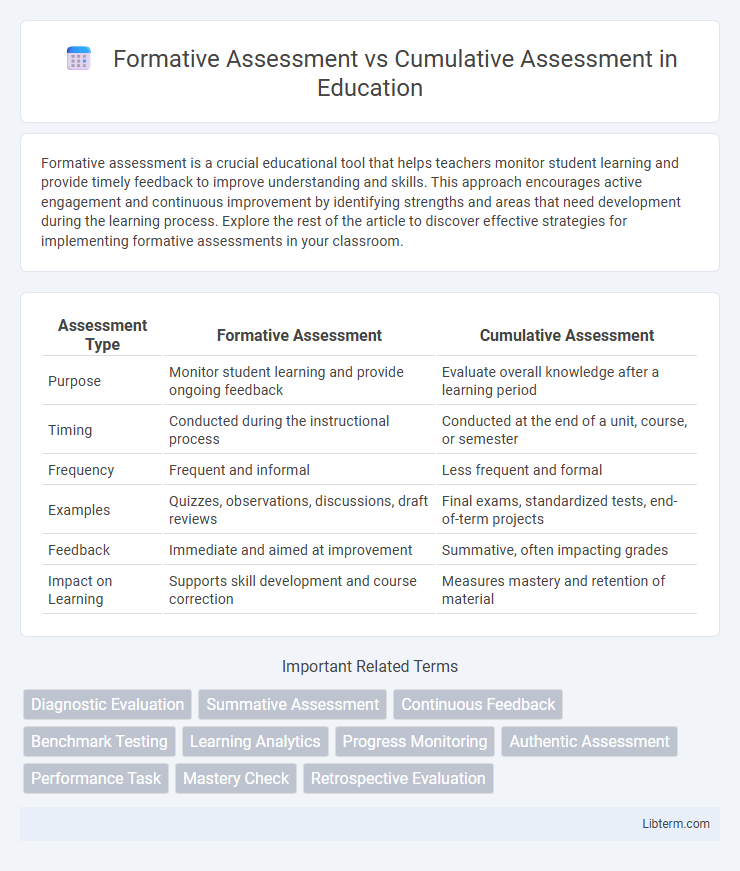Formative assessment is a crucial educational tool that helps teachers monitor student learning and provide timely feedback to improve understanding and skills. This approach encourages active engagement and continuous improvement by identifying strengths and areas that need development during the learning process. Explore the rest of the article to discover effective strategies for implementing formative assessments in your classroom.
Table of Comparison
| Assessment Type | Formative Assessment | Cumulative Assessment |
|---|---|---|
| Purpose | Monitor student learning and provide ongoing feedback | Evaluate overall knowledge after a learning period |
| Timing | Conducted during the instructional process | Conducted at the end of a unit, course, or semester |
| Frequency | Frequent and informal | Less frequent and formal |
| Examples | Quizzes, observations, discussions, draft reviews | Final exams, standardized tests, end-of-term projects |
| Feedback | Immediate and aimed at improvement | Summative, often impacting grades |
| Impact on Learning | Supports skill development and course correction | Measures mastery and retention of material |
Understanding Formative Assessment
Formative assessment is an ongoing process used by educators to monitor student learning and provide immediate feedback that guides instructional adjustments. It focuses on identifying areas where students struggle, promoting active engagement, and supporting skill development before final evaluations. This type of assessment includes quizzes, observations, and discussions aimed at improving comprehension and learning outcomes throughout the course.
Defining Cumulative Assessment
Cumulative assessment evaluates students' retention and understanding of material covered over an extended period, often encompassing multiple units or an entire course. It measures long-term knowledge consolidation and mastery by integrating previously learned concepts into a comprehensive evaluation. This type of assessment is essential for tracking overall academic progress and identifying areas requiring reinforcement.
Key Differences Between Formative and Cumulative Assessments
Formative assessment involves ongoing feedback during the learning process to identify students' strengths and areas for improvement, enhancing learning in real time. Cumulative assessment evaluates overall knowledge and skills at the end of an instructional period, measuring retention and mastery of the content. Key differences include the timing of assessment, purpose--formative for learning enhancement, cumulative for final evaluation--and the scope of content covered, with formative focusing on specific skills and cumulative encompassing entire units or courses.
Purposes of Formative Assessment in Education
Formative Assessment aims to monitor student learning and provide ongoing feedback that can be used by instructors to improve teaching and by students to enhance their learning process. Its purpose is to identify learning gaps early, tailor instruction to meet individual needs, and foster student self-regulation and motivation. Unlike cumulative assessment, which evaluates overall achievement at the end of a learning period, formative assessment supports continuous learning improvement and skill development.
Goals and Objectives of Cumulative Assessment
Cumulative assessment aims to evaluate a student's comprehensive understanding and long-term retention of course material by measuring knowledge, skills, and competencies acquired over an extended period. Its primary objectives include identifying gaps in learning, ensuring mastery of prerequisite concepts, and promoting reinforcement of key topics critical for academic progression. This type of assessment supports summative decision-making, such as final grading and certification, by providing a holistic overview of student performance.
Impact on Student Learning Outcomes
Formative assessment provides ongoing feedback that allows students to identify strengths and weaknesses, promoting active learning and skill development throughout the instructional process. Cumulative assessment evaluates overall knowledge at the end of a learning period, measuring retention and mastery of content. Research shows formative assessments significantly improve student engagement and learning outcomes by fostering continuous improvement, whereas cumulative assessments primarily serve summative evaluation purposes.
Examples of Formative Assessment Strategies
Formative assessment strategies include techniques such as quizzes, think-pair-share activities, exit tickets, and peer reviews that provide ongoing feedback during the learning process. Teachers use observations, class discussions, and interactive assignments to monitor student understanding and adjust instruction accordingly. These approaches promote active learning and help identify areas needing improvement before final evaluations like cumulative assessments.
Common Cumulative Assessment Methods
Common cumulative assessment methods include final exams, end-of-term projects, and standardized tests, designed to evaluate student learning over an extended period by covering comprehensive course content. These assessments emphasize retention, understanding, and the ability to synthesize information accumulated throughout the instructional period. Unlike formative assessments that provide ongoing feedback, cumulative assessments serve as summative evaluations measuring overall achievement and mastery.
Choosing the Right Assessment Type
Choosing the right assessment type depends on the educational goals and student needs, with formative assessment providing ongoing feedback to guide learning improvements and cumulative assessment evaluating overall knowledge at the end of a course. Formative assessments such as quizzes, peer reviews, and draft submissions help identify learning gaps early, allowing timely instructional adjustments. Cumulative assessments like final exams and comprehensive projects measure mastery and retention, making them essential for summative evaluation and certification purposes.
Integrating Formative and Cumulative Assessments for Effective Learning
Integrating formative and cumulative assessments enhances learning by providing continuous feedback while measuring overall knowledge retention. Formative assessments identify learning gaps in real-time, enabling targeted interventions and skill development. Combining these with cumulative assessments ensures a comprehensive evaluation of student progress and mastery over time.
Formative Assessment Infographic

 libterm.com
libterm.com